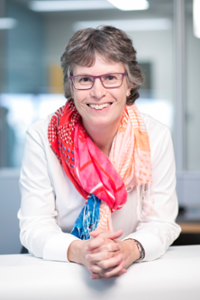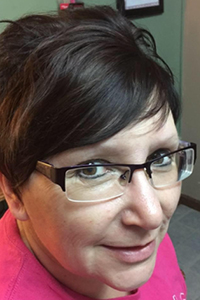
Saving Lives: Investing in breast cancer screening research
Dr. Cheryl Camillo (PhD) has been awarded a $102,660 SHRF Establishment Grant to improve the efficiency and effectiveness of the free provincial breast cancer screening program.
By Erica Schindel, Communications and Marketing Manager, Johnson Shoyama Graduate School of Public PolicyBreast cancer is the most common malignancy and the second leading cause of death among Canadian women. According to the Public Health Agency of Canada (PHAC), breast cancer accounts for approximately 25 per cent of new cases of cancer and 13 per cent of all cancer deaths in Canadian women. In 2020 alone, the Canadian Cancer Society estimates that 27,400 women will be diagnosed with breast cancer, and 5,100 will lose their fight—that is a staggering 14 women per day.
The Canadian Task Force on Preventive Health Care (CTFPHC) recommends that average-risk, asymptomatic women between the ages of 50 and 74 have a mammogram once every 2 to 3 years. This is based on evidence that sustained mammography screening is associated with lower breast cancer mortality. So the key to breast cancer survival is early diagnosis and treatment.
Women with stage 1 breast cancer have a 100 per cent likelihood of surviving five years post-diagnosis. This survival rate decreases dramatically to 22 per cent for women diagnosed with stage 4 breast cancer.
Preventative measures, such as provincial and territorial screening programs, are the key to early detection of breast abnormalities and give women the best fighting chance at survival.
“In the early stages, there are often no symptoms of cancer,” says Dr. Kevin Wilson, Vice President of Population Health, Quality and Research, Saskatchewan Cancer Agency. “With regular screening mammograms, changes in the breast can be detected even early when they are too small for you or the doctor to feel or see. Approximately 75 per cent of breast cancers diagnosed through screening programs are early stage.”
The current national target is that at least 70 per cent of women be screened within 30 months of becoming eligible. The national target for rescreening (or retention or recall) after an initial normal mammogram is 75 per cent and after a subsequent screen is 90 per cent. However, in Saskatchewan, fewer than 40 per cent of eligible women go for their free screening mammograms through the Screening Program for Breast Cancer (SPBC), and that participation rate has been steadily declining.
But why? This is a question that Cheryl Camillo, JSGS associate professor and former Master of Health Administration program director, hopes to explore through her project Maximizing Saskatchewan Breast Cancer Screening Program Rates through Patient-Partnered Research.

“Once we understand why women aren’t going for free mammograms, our patient-oriented research team will provide the Saskatchewan Cancer Agency with information and actionable changes it can make to increase participation rates,” says Camillo.
Funded by the Saskatchewan Health Research Foundation’s Establishment Grant and in collaboration with the Saskatchewan Cancer Agency (SCA), Camillo hopes to fill a gap in understanding and in doing so will help improve the efficiency and effectiveness of provincial programming. Camillo’s patient-centred research will be conducted in collaboration with the SCA, patient partners, and communities across Saskatchewan, including Indigenous and rural communities.
“Dr. Camillo’s team is a true example of collaboration and engagement of the right people who have the insights and expertise to lead to real change,” says Patrick Odnokon, SHRF Chief Executive Officer. “Health research on preventative measures and cancer can inform policy and programs and have an incredible impact on the overall health of our province. We are excited to see this collaborative work, led by Dr. Camillo, to find home-grown solutions to this health challenge that affects so many Saskatchewan people.”Searching for Answers
“There are a number of risk factors that have been identified that increase a woman’s chance of developing cancer. These include age, family history, BRCA gene mutations, reproductive status, hormone exposure, alcohol and obesity,” says Camillo. “But what we don’t know is if there are additional factors to consider that work against the acceptance of screening, therefore furthering the risk. For instance, are there social, psychological, cultural, economic, educational, geographical, and technological barriers that need to be considered when understanding why eligible women don’t get screened.”
Camillo’s research team will analyze recent conceptual frameworks for effective screening and identify barriers and facilitators of breast cancer screening in Saskatchewan.
“There have been a number of small-scale studies of distinct communities in Canada, the United States, and other countries that suggest that demographic characteristics, such as immigration status, impact screening decisions,” says Camillo. “However, these studies do not provide sufficient evidence to guide provincial reforms here in our province.”
Under the auspices of the Saskatchewan Cancer Agency, the province implemented its first breast screening program in 1990. It has changed relatively little since then.
Currently, the SPBC provides a free digital screening mammogram every two years to asymptomatic women who are registered in eHealth's Person Health Registration System and are over age 50. Program mammograms are provided at two permanent centres in Regina and Saskatoon, six satellite centres distributed across the province in Lloydminster, Moose Jaw, North Battleford, Prince Albert, Swift Current, and Yorkton, and on a mobile bus. Eligible women receive letters of invitation, but can also participate via self-referral or physician referral. Women under age 75 are recalled via a letter from the SCA and are sent a reminder letter two weeks before the scheduled mammography date if they have not confirmed.
By reviewing the existing SPBC program and talking to existing patients, providers and system officials, Camillo’s team will collect information on program attributes such as screening guidelines, screening technologies, locations, initial recruitment methods, appointment processes, and population outreach and recall methods.
With a focus on vulnerable and underrepresented groups, the research team will also conduct approximately 100 interviews in at least eight communities across the province. Of those interviewed, some will have never been screened, others screened once, and the rest screened regularly. Based on their findings, the research team will be able to detect patterns and draw conclusions regarding the accessibility and acceptability of the current breast cancer screening program.Louise Bird’s story

Cancer has a tremendous impact on the physical, mental, social and financial health of patients and their families. This weight usually extends to their friends and the greater community in which they interact.
This is an all too familiar scenario for Louise Bird, a two-time cancer survivor, mother of four children and one step-child, and grandma to ten grandchildren. She is also a patient partner working with Camillo’s research team.
“I had cancer, it didn’t have me,” says Bird. “When I was first diagnosed, I made the conscious decision to fight for my life—even during the lowest of points.”
A resident of Wawota, SK, Bird was first diagnosed with HER2-Positive Breast Cancer at the age of 37. More aggressive than other types of breast cancer, HER2-Positive Breast Cancer is a type of cancer that tests positive for a protein called protein human epidermal growth factor receptor 2 (HER2). This protein promotes the growth of breast cancer cells. Bird received multiple rounds of chemotherapy, underwent surgery and had radiation treatments. After finishing her treatment plan in 2002, Bird’s reality hit a wall. She found another lump.
Tests concluded that her cancer had returned, and once again she started chemotherapy. However, this time her tumour was not responding to the treatment plan and her body was in a much weaker state. She was diagnosed with Estrogen Receptor Positive Breast Cancer—meaning that there were estrogen receptors on the surface of her breast cancer cells that bound to estrogen hormones, affecting the behaviour or growth of the cells.
Bird began radiation therapy to shrink the tumour enough to qualify for surgery. She credits radiation therapy for essentially saving her life and her medical team for supporting her along the way.
“When you think about everything in your life that you have control over, it isn’t much,” says Bird. “But you do control your own words and the actions that you take. In working with Dr. Cheryl Camillo and her research team, I want to find ways of improving the SPBC program and reaching other women to encourage them to get screened. You only have one life, so you need to take care of it.”
Creating room for improvement
“The SCA has little evidence from which to draw actionable conclusions as to why increasing numbers of Saskatchewan women are declining to participate in the SPBC,” says Camillo. “This is where our research will hopefully fill some of the gaps and provide additional insight into program modifications that could stimulate participation.”
As part of phase two of the two-year study, Camillo will produce actionable, evidence-based, patient-oriented strategies to effectively raise the SPBC’s participation and retention rates.
“If we can redesign Saskatchewan’s breast cancer screening program and recruitment methods, increase screening rates and improve early detection of breast abnormalities, we can reduce the number of women being diagnosed with late-stage cancer,” says Camillo. “Not only will this impact and benefit the health of women in our province, which is the priority, but it can have ripple effects on our public health spending and economy.”
The findings can also be extended to and adopted by other provinces and territories through the Canadian Partnership Against Cancer.
“The health care system in Canada invests significantly in technologies that treat illness and disease, but less so on programs and measures that prevent illness and disease,” says Camillo. “What we hope, is that with this research we can get ahead of the problem by creating policy reforms and programs that will keep people well and healthy.”
--
The Saskatchewan Health Research Foundation's Establishment Grant program assists researchers who are new or newly resident in Saskatchewan in establishing an independent program of health research in the province. Past recipients often credit this funding as the support that helped them launch their research careers and achieve the productivity necessary to obtain major funding from national and other external agencies.
For a complete list of award recipients, visit SHRF's Establishment Grant Results database, or the University of Regina and University of Saskatchewan websites.

